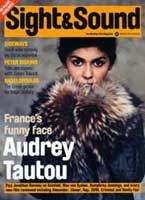
A Hole in My Heart
Sweden/Denmark 2004

Reviewed by Ryan Gilbey
Synopsis
Our synopses give away the plot in full, including surprise twists.
In a suburban Swedish apartment, Rickard (Thorsten Flinck) is directing a pornographic video starring his friend Geko (Goran Marjanovic) and a young woman named Tess.(Sanna Bråding) Rickard's teenage son Eric (Björn Almroth) tries to ignore what is happening. During the course of filming, he is befriended by Tess, and fantasises about shooting his father. The atmosphere in the apartment becomes tense after Geko falls asleep during sex, and Tess teases him. Geko and Rickard threaten Tess with violence. She leaves, but later returns with a trolley full of groceries, prompting a food fight that ends with Geko vomiting into Tess' mouth. Tess and Eric are last seen taking turns climbing into a washing machine.
Review
European art cinema has struggled to describe the decline of western civilisation under consumerism as eloquently as Godard did in his never-ending tracking shot of a lawless traffic jam in Weekend (1967). Michael Haneke has come closest in Benny's Video (1992), 71 Fragments of a Chronology of Chance (1994) and Code Unknown (2000). Now Lukas Moodysson has a pop in A Hole in My Heart, which details the making of a pornographic video by the amateur director Rickard, the insecure stud Geko and the starry-eyed leading lady Tess. Along with Rickard's teenage son Eric, who hides in his bedroom nursing the same filial embarrassment as Saffron in Absolutely Fabulous, they form another of Moodysson's disjointed families, like the commune of Together (2001) and the daughter abused by interchangeable father figures in Lilya 4-Ever (2003).
It will be no surprise if the new film becomes notorious for the food fight sequence, during which Geko vomits into Tess' willing mouth. Moodysson puts great skill into choreographing this degrading pantomime; he clearly regards it as the film's dramatic climax, not to mention a distillation of the social ills he has diagnosed. He might be nonplussed to learn that the sequence plays like a run-of-the-mill Jackass outtake.
Doubtless he would argue that anyone who remains untroubled by this spectacle is already fatally inured to the forces against which the movie rails. Moodysson's main beef is with reality television: in an insidious scene that encourages the audience's sneers, Tess sheds a tear over her failed audition for Big Brother. Next in line are violent computer games, like those enjoyed by Rickard and Geko before they get their hands on actual firearms and use a decapitated centrefold picture for target practice (the objectification of women is also on Moodysson's list of bugbears).
These are symptoms of a general epidemic of consumerism that is addressed directly when Tess leaves the apartment to which most of the action is confined. She visits a supermarket where shoppers mill around with blurred grey faces. This is ostensibly to protect the identities of real people, who might be less than delighted to find themselves making their screen debuts in between gruesome dissections of plastic vaginas. But it has the unusual effect of transforming these extras into blob-headed Martians. Moodysson also blanks out all logos and labels, possibly to deny the manufacturers the benefits of product placement. Pepsi must be gnashing its teeth over that one.
If that's the reason for the optical smudging, the companies concerned got off lightly. In Lilya 4-Ever, the heroine feasted at McDonalds immediately after being inducted into prostitution. The scene provided more effective aversion therapy than anything in Super Size Me.
Lilya 4-Ever marked a dramatic darkening after the optimism of Moodysson's 1998 Show Me Love and Together. With A Hole in My Heart, the director has made a more tentative departure, this time from conventional narrative, preferring to evoke the end of the world as we know it through subliminal imagery, blasts of abstract noise, video diaries and non-linear editing. Sexually explicit scenes are played out by dolls in an echo of that superior anti-consumerist tirade, Superstar The Karen Carpenter Story.
One advantage is that the audience sometimes knows less about what's going on than the characters do. Following the food fight, there is a shot of Rickard, Geko and Tess joined in a tender embrace. The jumbled editing makes it difficult to fathom where in the narrative that embrace belongs. In a film that makes its message all too transparent, this ellipsis provides precious ambiguity. It seems strange to complain that a film makes too much sense, but that's certainly the case with A Hole in My Heart. Moodysson wants the liberties of experimental cinema, but he is unwilling to surrender the old comforts of narrative film-making. There are strategic climaxes here, just as in any mainstream film, only these revolve around sexual and emotional humiliation. And the symmetrical backstories and psychological flaws in which Moodysson drapes his characters are cut from the same cloth as the most schematic Ronald Bass screenplay. How much more jarring, for example, if Rickard's exhortation to his son - "Come on, Eric, we're going to beat up Grandad!" - had been left as a nonsequitur, rather than being substantiated by the revelation that Rickard was raped by his father.
The more taboo moments in Moodysson's picture suggest that it is just Pink Flamingos with a liberal conscience. The truth is worse than that. It's Pink Flamingos with a message, excessive character motivation, delusions of grandeur and a phoney poker face.
Credits
- Director
- Lukas Moodysson
- Producer
- Lars Jönsson
- Screenplay
- Lukas Moodysson
- Photography
- Malin Fornander
- Jesper Kurlandsky
- Lukas Moodysson
- Karl Strandlind
- Editor
- Michal Leszczylowski
- Art Direction
- Malin Fornander
- Jesper Kurlandsky
- Lukas Moodysson
- Karl Strandlind
